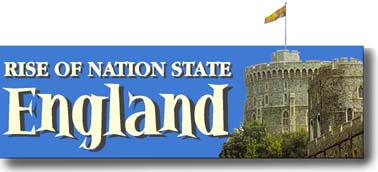|
Highlands Ranch High School - Mr. Sedivy
Highlands Ranch, Colorado
Rise of Nation State England
- 100 Years War -
Henry V, Agincourt, King Charles VI,
The Battle at Calais, Treaty of Troyes
Henry V (1413 - 1422)
Not until 1413 did England have a king who would be willing and
able to continue the fight. Henry claimed to the rightful king of
France.

During his Irish campaign, Richard knights Henry
of Monmouth (the future King Henry V), son of the exiled Henry Bolingbroke
who took advantage of Richard's absence to return to England and
usurp the the throne.
In 1415, Henry V snatched a victory at Agincourt,
against all odds. He won by luck and by using his skills in difficult
circumstances. Some 6000 French were dead, and the English lost
400 lives.

Henry V defeated the French in the Battle of Agincourt.
For the next five years,
Henry concentrated on completing his French conquests.
Henry V also conducted a blitzkrieg in Normandy during
1417 - 1419. The English believed that God was on the side of England
and its kings.
King Charles VI (1380 - 1422)
King Charles VI suffered from fits of madness and could not control
his nobles who were always quarreling. Henry took advantage of this
and landed in Normandy in 1415 with 8000 men. After a five-week
siege, he captured the port of Harfleur. The down side was dysentery
which reduced his army to 6000.

The death of Charles VI in 1422 was an occasion for
an elaborate
state funeral arranged by the Duke of Bedford. Charles VI's death
signaled
a monumental seven-year struggle for succession to the throne.
The Battle at Calais
Henry marched north to Calais planning to return home. On the way,
Henry was surprised by a French army with 20,000 men. He was forced
to fight in a heavily wooded area. It was late October and it had
been raining for several days. He positioned his troops between a
gap in the woods and ordered his archers to stick sharp wooden stakes
in the ground in front of them.
Two groups of knights attacked the wings of the English army and
the main French force of foot soldiers advanced down the middle.
The knights were driven back by the archers before they reached
the English lines. Meanwhile, the French foot-soldiers found their
heavy chain mail a great handicap as they struggled across the deep
mud. The gap between the forests narrowed as the French came forward.
The result was that they were crammed together like sardines.
A French source wrote:
"Before they could come to close
quarters many of the French were disabled or wounded by arrows -
and when they came close to the English they were so close together
they could not raise their arms to strike."
Many of the French sunk up to their thighs in mud. The English
archers saw their chance and rushed the French using swords and
knives. The battle was won. Approximately 7000 French lay dead -
the English only lost a few hundred.
For more information about the 100
Years War,
please see Mr. Sedivy's World History - The Middle Ages:
The Hundred Years War
The Treaty of Troyes
Henry went home to hero's welcome. Later he returned to France,
and within five years Henry had conquered all of northern France.
The powerful Duke of Burgundy went over to Henry's side. In 1420,
the French queen made peace - The Treaty of Troyes. Henry got to
keep all the land. Henry would marry her daughter, Catherine, and
take the French crown when her insane husband Charles VI died.

The marriage of King Henry V and King Charles VI's
daughter, Catherine of Valois,
at St. John's Church, Troyes, in 1420. Her dowry was 600,000 crowns.

Charles VII, mounted with a sword, chases King Henry
VI out of France.
The main instrument of French success 1449 - 1453, the cannon, is
represented by two cannons in the background. From The Chronicles
of the Kings of France c.1483.
Back to top of page
Mr. Sedivy's Lecture Notes
& Historical Info
The Celts
| Gallic He-Men | Celtic
Culture, Trade, Religion, Women |
| Threat of the Celts - Celtic Battles and
Conquests |
- Rise of Nation State England -
| Roman Conquest of Britain | Christianity
in Britain |
| Customs: Thanes, Churls, Thralls, Wergeld,
Folk-Moot |
| Dark Ages: Alfred the Great, Edward the
Elder, Athelstan |
| The Return of the Vikings |
| Kings of Britain: Aethelred, Cnut, Edward
the Confessor |
| Bayeaux Tapestry, William the Conqueror,
Edward the Confessor, Harold Godwinson, Harold II |
| The Crusades: Richard Lion Heart, Pope
Urban |
| King John, Innocent III, Archbishop Stephen
Langton |
| Magna Carta / First Parliament |
Wales and Scotland
| Wales: Edward I, Llewellyn, Snowdonia
|
| Scotland: Alexander III, John Balliol,
William Wallace, Robert Bruce, King Edward II |
The 100 Years War
| Edward III, Longbows at Crecy, Edward IV,
Black Prince |
| Henry V, King Charles VI, Battle at Calais,
Treaty of Troyes |
More Information
| Other Kings of the Dark and Middle Ages:
William II, Henry I, Henry II |
| The
British Monarchy's Peerage: Dukes, Viscounts,
Marquess, Earls, Baronets, and Barons |
Class Activities
Roman Conquest Comparison
Battle of Agincourt
Related Information
Mr. Sedivy's World History - The Middle
Ages
The Complete Bayeux Tapestry
Roman Catholic Church in the Middle Ages
/ Crusades
The Hundred Years War
King Henry VIII
The Interesting
Life of Elizabeth I
The Stuarts - James I, Charles I, Charles
II, James II
Oliver Cromwell
|



![]() 9375 South Cresthill Lane
9375 South Cresthill Lane ![]() Highlands Ranch, Colorado 80126
Highlands Ranch, Colorado 80126 ![]() 303-471-7000
303-471-7000





